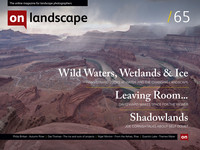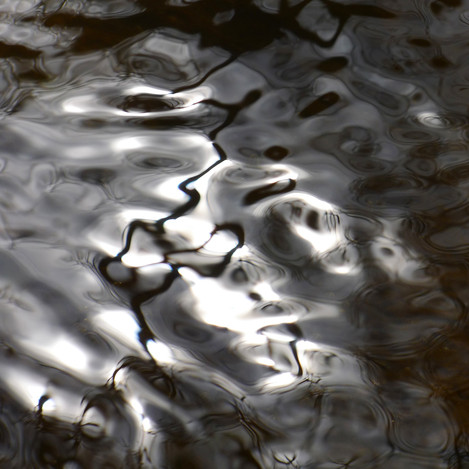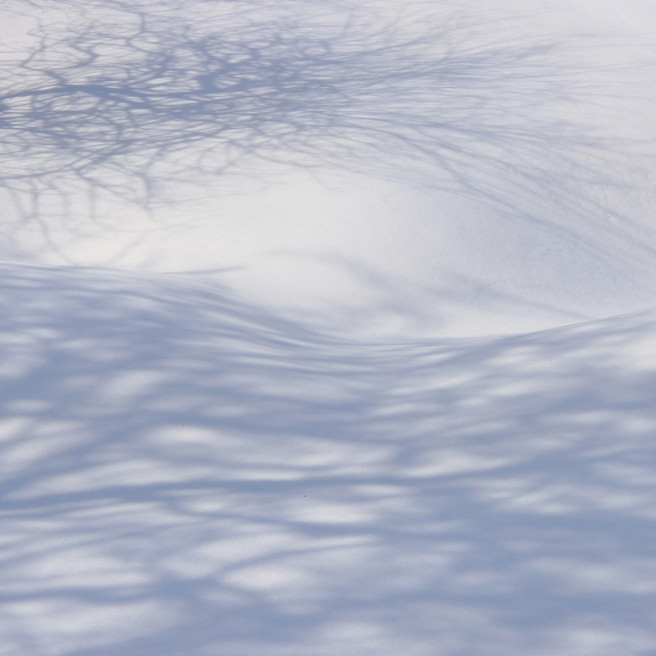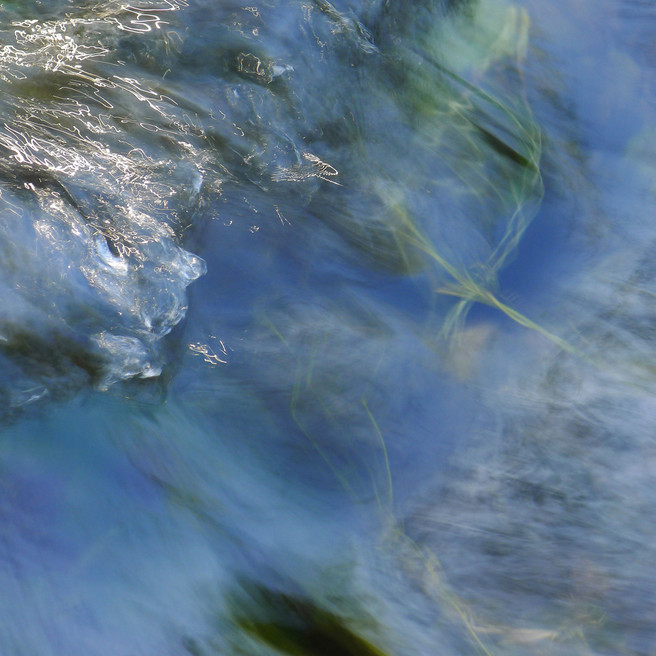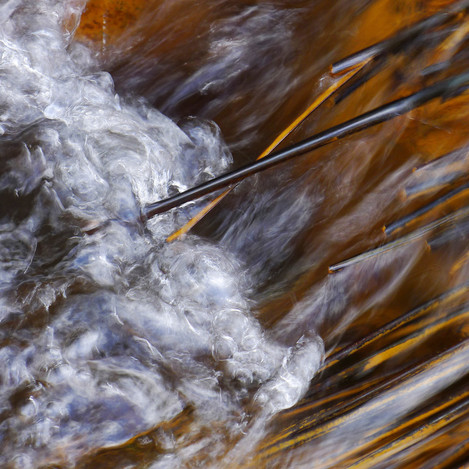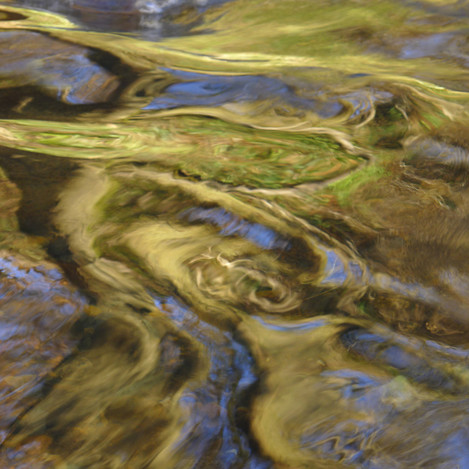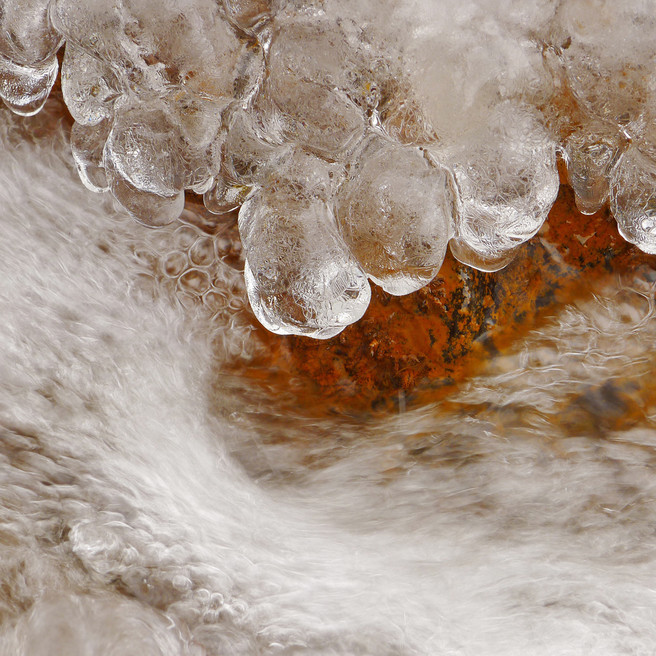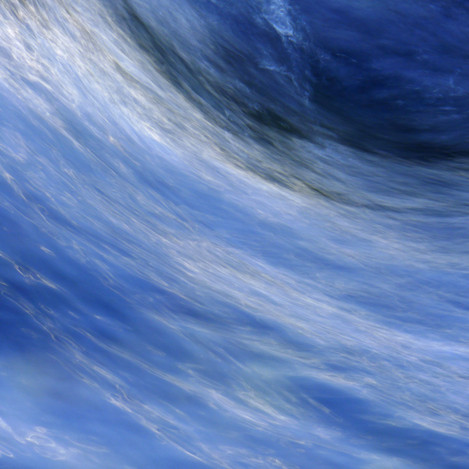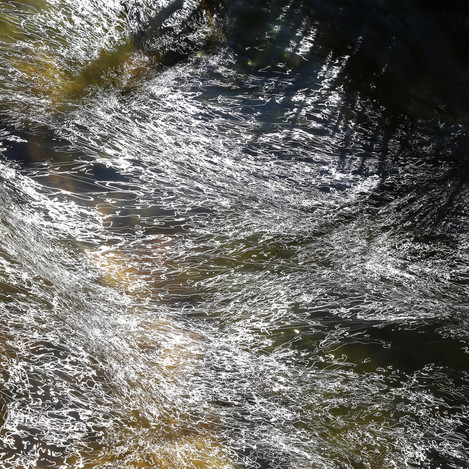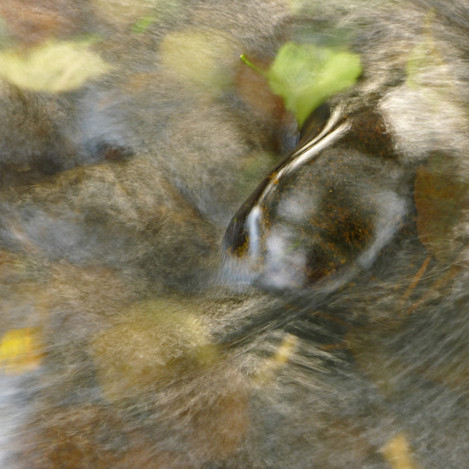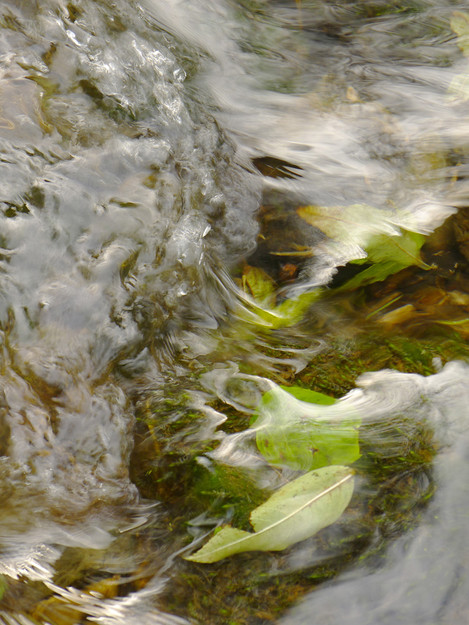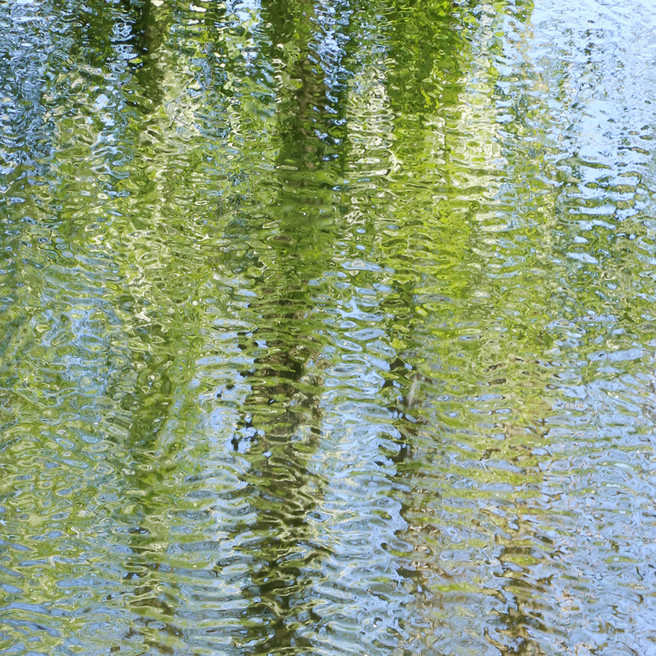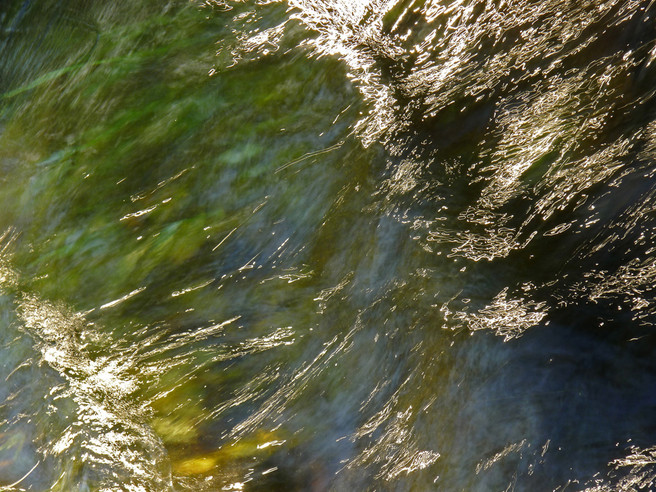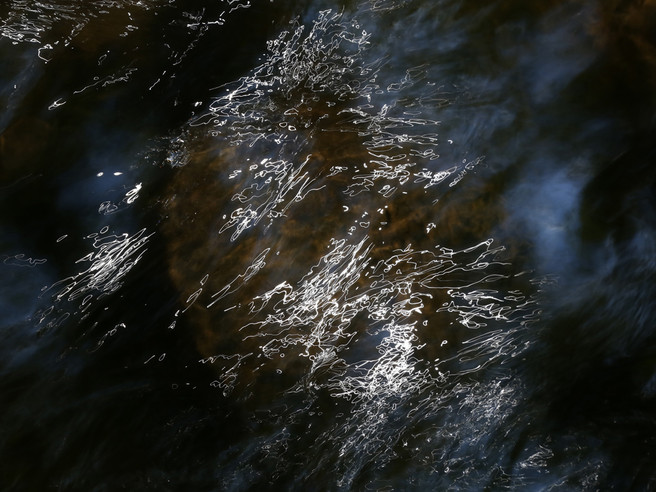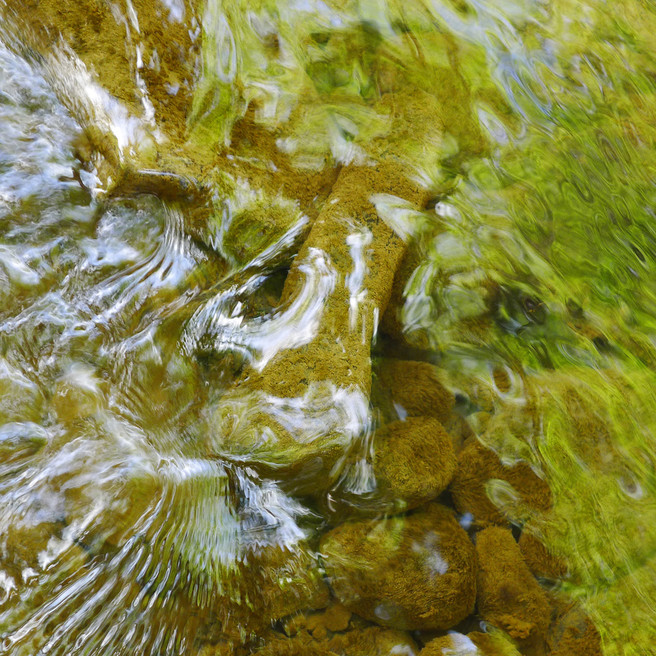Why Surface Tension can have Hidden Depths

Michéla Griffith
In 2012 I paused by my local river and everything changed. I’ve moved away from what many expect photographs to be: my images deconstruct the literal and reimagine the subjective, reflecting the curiosity that water has inspired in my practice. Water has been my conduit: it has sharpened my vision, given me permission to experiment and continues to introduce me to new ways of seeing.
“It all depends on how we look at things, and not how they are in themselves.” Carl Gustav Jung
Over the last two years I’ve periodically experienced a sense of frustration and a feeling that my photography is not progressing. Other factors haven’t helped, but sometimes frustration creates new opportunities. I wrote about the direction that summer 2012’s poor weather took me in in “Going with the Flow”. There is a sense, a year on, of coming full circle – one year, one month on, and from wet to dry.
It is all too easy to succumb to the temptation to keep making images. But in the same way that it can be constructive on photo excursions to pause, I feel the need to do so now as part of my own personal development, to take stock of the portfolio that has developed, and the direction this is taking me in. Purely coincidentally I came across a recent article by Alan Briot about motivation. In reading this, I find echoes for my current, contemplative, mood, and a number of parallels. Such writing makes far more sense to me now than in 2006 when I stumblingly attempted to describe what ‘Vision and Style’ meant to me. The image of mine included in the book ‘Developing Vision and Style’ said things slightly better, and ironically it was also an intimate detail of a stream. Another echo? If I’ve inadvertently returned to this point, hopefully the intervening period has not been in vain. My reading has prompted me to ask myself a number of questions, which appear as a thread running through this article.
Why do I photograph? For myself, firstly, and secondly for an audience. Because it makes me happy. Because it gets me outside. Because I experience places on an individual basis. Because I see things in new ways. Because it is creative. Because I lose all sense of time and self. Because I can express myself.
"why"
Why do I photograph? For myself, firstly, and secondly for an audience. Because it makes me happy. Because it gets me outside. Because I experience places on an individual basis. Because I see things in new ways. Because it is creative. Because I lose all sense of time and self. Because I can express myself.Photography has always felt to me to be something instinctive. But inevitably there are so many things of interest that we tend to jump about. I now wonder if this can be counter-productive; certainly by concentrating on a subject and style of image making over the past 12 months, I have learnt much more about myself and my relationship with the camera.
When have I felt inspired? When I am at one with nature. When I slow down, or stop. When the light comes, and goes. In snow. In mist. In autumn and spring. At the water’s edge. When I look down a macro lens. When I open my mind as well as my eyes.
In the beginning, my inspiration came from the camera as a creative tool. It gave me a new way of looking at landform, composition and detail. Second time round, my inspiration came from the images I saw and the books I read, the work of others; from understanding the qualities of the light; and from pattern and texture. More recently, it has tended to come from change in the landscape and from little seen, or unseen.
For some years I have persisted with the notion that my photography is about place and not person - hence my choice of domain name – but I now realise that this is increasingly not true and I contemplate breaking free from my self-imposed straight jacket. I now understand that my images come from within as much as without. I understand that we each see and appreciate things in our own way, that we each bring different things to our love of photography, and that our images should reflect this, rather than simply follow the work of others.
I understand that our vision develops over time. Our influences – famous photographers and peers alike – shine a light to guide our way. But after a while we need to find our own path, our own way of doing things – our own way of seeing. After a while, we risk becoming stale (moribund?) if we simply create more of the same.
That thinking about what and why we make images is as important as making images.
Why do I photograph water? To create images that are aesthetically pleasing. To explore light, form, texture and colour. Because it is ever changing. Because it adds other dimensions – such as time and movement – to my images. Because there is, for me, a richness missing from ‘literal’ photographic interpretations.
My preferred style of photography is now much more personal. I’ve always enjoyed finding images that are less obvious (“something from nothing” comes to mind) and for some time there has been an appeal in the short-lived and ephemeral. Perhaps this is part of the attraction of seeking art from the alchemy of water and light – nothing is ever the same. Form, features, colour and texture are all part of the images, but it is, first and foremost, about the light on the water, the way that this combines with the movement, and the emotions this invokes……curiosity, anticipation, wonder, joy – sometimes frustration and disappointment – sometimes satisfaction, perhaps admiration. Do the images tell a story? Each image conveys a unique point in time. Even more so than on land, an image cannot be repeated. In addition to revealing patterns of flow and of light, each reflects the underlying geology, the character of the day, the legacy of rain and the energy of the stream. The seasons play a part, though not always as expected – some of the brightest images have been made between October and December.
What do I gain from it? Enjoyment. Technical and creative development. A new vocabulary. The images take me back to my childhood love of drawing and painting. The surface of the water softens, but retains life and detail. Trails of light can be recorded on the surface as abstract lines, scribbles and paint-like splashes. Some images seem to blur the boundaries between photography and painting, and this is perhaps their greatest appeal to me, along with the ability to literally “draw with the light”.
Which images give me particular satisfaction? Mostly those that combine a strong composition or framework with the colour and the effects achieved in freezing the moment. Or those that show something transient or unexpected.
At the time of writing “Going with the Flow”, my initial focus had shifted from the Dove to a small tributary on the Staffordshire side, running over gritstone, between trees and along a hedgerow. An interplay of light and shade; a darker mood, tending towards warmer colours. Oxide stained. “Of the earth.” As well as “Vortex”, “Backflow (The Wave)” and “Whirlpool”, which all featured in “Going with the Flow”, from this source have come images such as “Ice on Rust”, “Black Reed”, and “What Lies Beneath”, unexpected gifts from the late and cold spring which completely transformed a boggy section of stream.
Then one day I wondered if there were images to be made from a second stream on the Derbyshire side. This was more open, less eventful, and had seemed to offer less potential, but a second strand developed, running fast and clear over limestone. A brighter mood and colours. “Of the sky.” Here I found “Cool Blue” which shows that yes, deep shadow on a sunny day really is blue, as well as the textural and colour contrasts and apparent depth of “Dissolve” and “Lime Light”. And in contrast, “Dark Shadow”, which as with “Grass, Reflected II” realised my feeling that the sunlight and shadows were hiding compositions that only the camera could reveal.
There have been times when I have not found images that I am happy with – when storm surges drape the banks with debris; when the wind whips the snow around too much; when the water runs brown after a night of heavy rain; when the streams shallow to a trickle in a summer heatwave. I do sometimes think of trying to capture the stream in wider view, but it’s rarely photogenic, and my inspiration has so far come from finding images within the view. I guess that there are other images that could have been made, but that would be another story, and not one that, so far, I have wanted to tell. But in writing this, and thinking some more, I may now review this decision as it occurs to me that there is an argument to be made for doing this, as both context and counterpoint to my selections of aesthetic details.
I still periodically return to the Dove itself both locally and further downstream in Dove Dale, and find other textures such as “Day Dream” and “Liquid Gloss”, which I like for what they say about the infinitely varied visual properties of water, and “Nature as Artist”, a piece of more obvious photographic impressionism.
What do I hope to achieve? To develop my own vision. To show locations and subjects in a way that many do not see. To create connections by sharing my images with others. To gain constructive comment and, maybe, even recognition. To develop and improve as an artist as well as a photographer. Ultimately, perhaps, to create work comparable to the work of photographers that I admire.
I’ve never had any doubts about how to present the images. I still prefer a square format for aesthetic reasons, but occasionally use a rectangular format where this is required by the composition. There was also never any question but that they be printed on Hahnemuhle Photo Rag, which nicely complements their ‘painterly’ nature. Or as to how they should be framed – white mount, white frame. I’ve been told since that white frames are de rigeur in Cornish galleries, however I chose them without being aware of this simply as I wanted the frame and mount to merge and to act together to isolate the detail within. Part of me wonders if the size of print is important too - the images result from close observation and time slowly spent, and I have wondered if this should also be encouraged in the viewer by limiting print size, though I have recently been encouraged to produce 500mm prints.
I’ve started to dip my toes in the water, so to speak, and show some of the images. I entered and gained recognition for my work in this year’s local Staffordshire Moorlands Open Art Exhibition, and I had some of the images selected for a mixed exhibition at The Green Man Gallery, Buxton. My “streamscapes” featured in the June issue of Derbyshire’s “Artsbeat” magazine. More recently, I learnt that “Ice on Rust” had received a commendation in this year’s “Landscape Photographer of the Year” competition, one of two images to be shortlisted for the final round of judging.
I had previously been a little hesitant in taking things further in case this detracted from the inspiration and enjoyment I gain in creating the images, but decided that this is the logical next step. Initial feedback from artists and gallery owners has been positive - in some cases there has been surprise that they are indeed photographs – and my plans for the next year are taking shape and I have been selected as a new member by Peak District Artisans. Looking further ahead, there is certainly enough variety, interest and story in them for an exhibition, or for a book. Time will tell.
What type of images do I want to make? Individual. Things that I see, that others may not. That celebrate the genus locii, but have universal appeal. That are timeless? That exploit versatility of the medium. That stretch me, technically and creatively. That stand together as a collection. That continue to inspire and to motivate me.
How do they compare with those I am making? With water, there is a sense that I am making progress. “Going with the Flow” has changed the way I photograph – choosing to incorporate movement prompted a change to mostly digital from mostly film. I shoot (these) handheld. They are nearly always composed around the square format. I have a greater understanding of the way that the light interacts with the water and its movement, and of the potential to create images from seemingly insignificant incidents.
On land – perhaps a step change is needed. I find that the appeal of ‘conventional’ landscape photography and literal interpretations have dimmed for me. But as yet I haven’t worked out how to translate this. It seems perverse to largely turn my back on the local scenery, but for now at least I find my own view of the world within more satisfying. I have a greater interest in making, and appreciation of, abstract images, and some things have started to feed through into my macro work.
I wonder if further inspiration might come as much from art as from photographic example. I’m starting to think back to those artists whose work inspired me: Alphonse Mucha and Art Nouveau (that sense of flow); JMW Turner (his skies and seas); the Arts and Crafts’ movement (a symbiosis of line and curve)…... And about how I have subconsciously absorbed these and other influences, and how they shape my vision. And I can’t help but feel my membership of Peak District Artisans will be invaluable, offering me the opportunity to be inspired by the work of my fellow members, and to see things through new eyes and different media.
What do I hope others will get from my images? Enjoyment. To see the beauty in the small things around us. To understand the difference between looking and seeing. To recognise that photography can be used to create art like any other medium, if they do not already. To encourage others to experiment and to find their own creative voice.
I wonder about the importance of writing and interpretation for our images and collections of images. It’s not just what we photograph, but what we feel and how (or if) we choose to communicate this. Will others, especially non-photographers, understand or appreciate our images fully if they are unaware of their journey into existence? The more personal the vision or the greater the abstraction, the more helpful interpretation may be. With any new body of work, does the audience need to learn and understand the language of its creator? It’s already becoming apparent that some explanation is needed for others to understand what my images show.
Do I have a personal style? I still find this more difficult to answer and feel that this is a journey rather than a finite state. My style has certainly evolved over the last year, and hopefully these images together suggest something stronger than the sum of their parts. If the observer does indeed consider them to be art, then I’m delighted.
Over the year and in writing this, I find have learnt as much about myself and my motivation as about my photography. From experimentation and a greater focus has come a very different personal vision. These images are as I see things, and the feeling that this has engendered has spilt over into my occasional writings. It has opened up new avenues for me to explore and given me a greater pride in what I do. I have a greater desire to share my view of the world, and to communicate my vision, to show and even to exhibit. I’ve started to think in terms of artist as well as photographer – not in terms of judgement of my images (that is for others) but in terms of expressing myself through my art.
It’s funny where inspiration and creativity can take you. As with writing my previous article, this one has also evolved since I started it. It was originally intended to be a fairly straightforward look back over a year when I’ve largely immersed myself in my water world, but in considering this I have found myself straying into the realms of vision and personal style. I know now that my image making is in fact about person, not place. That I shouldn’t feel guilty about taking a different path, that I won’t create good work if my heart is not in it, and that recognition, if it does come, isn’t worth selling my soul for. As long as the inspiration remains, I’m happy to keep creating, and reflecting, and to see where this leads. I’m still very much “Going with the Flow”.
“Your vision will become clear only when you can look into your own heart. Who looks outside, dreams; who looks inside, awakens”. Carl Gustav Jung
- Black Reed
- Cool Blue
- Dance Over the Depths
- Dark Shadow
- Day Dream
- Dissolve
- Falling Over
- Ice on Rust
- Light Falls
- Lime Light
- Liquid Gloss
- Nature as Abstract Artist
- Screaming Waters
- The Colour Collector
- The Colours of Summer
- The Mirror Cracked
- Vortex II
- What Lies Beneath

